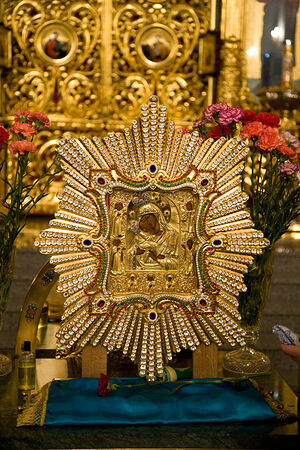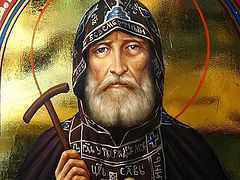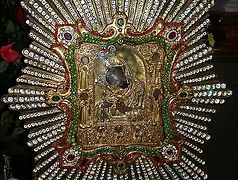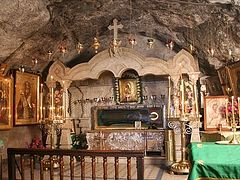 The Pochaev Icon of the Mother of God is among the most venerable sacred shrines of the Russian Church. It is renowned throughout all the Slavic world: It is venerated in Ukraine, Russia, in Bosnia, Serbia, Bulgaria and other places. Christians also of other confessions come to venerate the wonderworking image of the Most Holy Mother of God, alongside the Orthodox. At the Pochaev Lavra, an ancient rampart of Orthodoxy, the wonderworking icon has resided about 400 years. The miracles that have issued forth from the holy icon are numerous and are testified to in the monastery books with the inscriptions of the faithful, who with prayer have found deliverance from unclean spirits, liberation from captivity, and sinners brought to their senses. The celebration in honor of the Pochaev Icon of the Mother of God on July 23was established in memory of the deliverance Holy Dormition Pochaev Lavra from a Turkish siege on July 20–23, 1675.
The Pochaev Icon of the Mother of God is among the most venerable sacred shrines of the Russian Church. It is renowned throughout all the Slavic world: It is venerated in Ukraine, Russia, in Bosnia, Serbia, Bulgaria and other places. Christians also of other confessions come to venerate the wonderworking image of the Most Holy Mother of God, alongside the Orthodox. At the Pochaev Lavra, an ancient rampart of Orthodoxy, the wonderworking icon has resided about 400 years. The miracles that have issued forth from the holy icon are numerous and are testified to in the monastery books with the inscriptions of the faithful, who with prayer have found deliverance from unclean spirits, liberation from captivity, and sinners brought to their senses. The celebration in honor of the Pochaev Icon of the Mother of God on July 23was established in memory of the deliverance Holy Dormition Pochaev Lavra from a Turkish siege on July 20–23, 1675.
In the Summer of 1675, during the time of the Zbarazhsk War with the Turks, during the reign of the Polish king Jan Sobesski (1674–1696), regiments of Tatars under the command of Khan Nurredin fell via Vishnevets upon the Pochaev monastery, surrounding it on three sides. The weak monastery walls, just like some of the stone buildings of the monastery, did not offer much defense against a siege. The abbot, Fr. Joseph Dobromirsky, urged the brethren and laypeople to turn to their Heavenly intercessors—the Most Holy Mother of God and the Holy Father Job of Pochaev (Comm. October 28/November 10). The monks and the laypeople prayed fervently, prostrating themselves before the wonderworking image of the Mother of God and the reliquary with the relics of St. Job. On the morning of July 23, with the rising of the sun, as the Tatars were holding a final meeting about an assault on the monastery, the abbot ordered the singing of an Akathist to the Mother of God. With the first words, “Queen of the Heavenly Hosts”, suddenly there appeared over the church the Most Holy Mother of God Herself, in “an unfurled gleaming-white omophorion”, with heavenly angels holding unsheathed swords. St. Job stood beside the Mother of God, bowing to Her and beseeching the defense of the monastery. The Tatars took the heavenly army for an apparition, and in confusion they began to shoot arrows at the Most Holy Mother of God and St. Job, but the arrows fell backwards and wounded those who shot them. Terror seized the enemy. In a flight of panic and without looking, they trampled upon and killed each other. The defenders of the monastery pursued and took many prisoner. Some of the prisoners afterwards accepted the Christian faith and remained at the monastery.
In the year 1721, Pochaev was occupied by Uniates.[1] But even in this difficult time for the Lavra, the monastery chronicle notes 539 miracles from the glorified Orthodox sacred image. During the time of the Uniate rule in the second half of the XVIII Century, for example, the Uniate nobleman count Nicholas Pototski became a benefactor of the Pochaev Lavra through the following miraculous circumstance. Having accused his coachman for overturning the carriage with frenzied horses, the count took out a pistol to shoot him. The coachman, turning towards Pochaev Hill, reached his hands upwards and cried out: “Mother of God, manifest in the Pochaev icon, save me!” Pototski several times tried to shoot the pistol, which had never let him down, but the weapon misfired. The coachman remained alive. Pototski then immediately set off to the wonderworking icon and decided to devote himself and all his property to building up the monastery. From his wealth was built the Dormition cathedral and buildings for the brethren.
The return of Pochaev to the bosom of Orthodoxy in 1832 was marked by the miraculous healing of the blind maiden Anna Akimchukova, who had come on pilgrimage to the holy shrine together with her seventy-year-old grandmother, from Kremenets-Podolsk 200 versts[2] away. In memory of this event, the Volynia archbishop and Lavra Archimandrite Innokenty (1832–1840) established Saturdays weekly services of the cathedral akathist before the wonderworking icon. During the time of the rule of the Lavra by Archimandrite Agathangel, archbishop of Volynia (1866–1876), in memory of the victory over the Tatars, a separate chapel was constructed in the gallery of the Holy Trinity Church, and consecrated on July 23, 1875.



